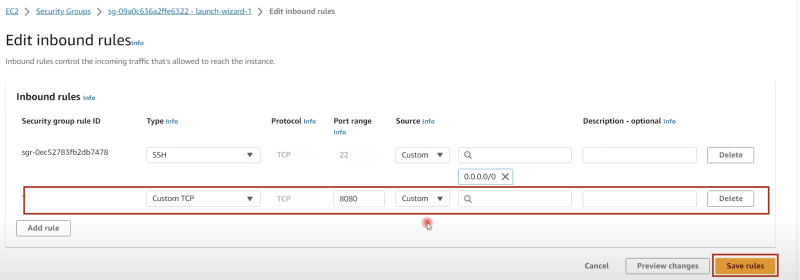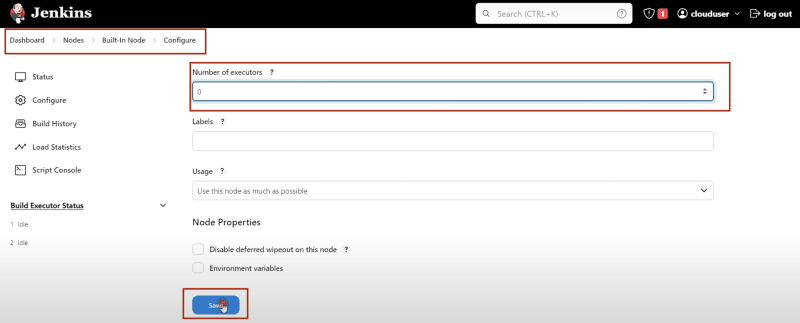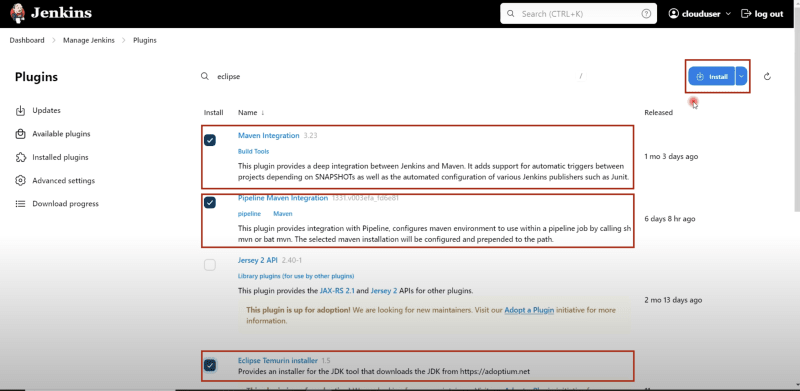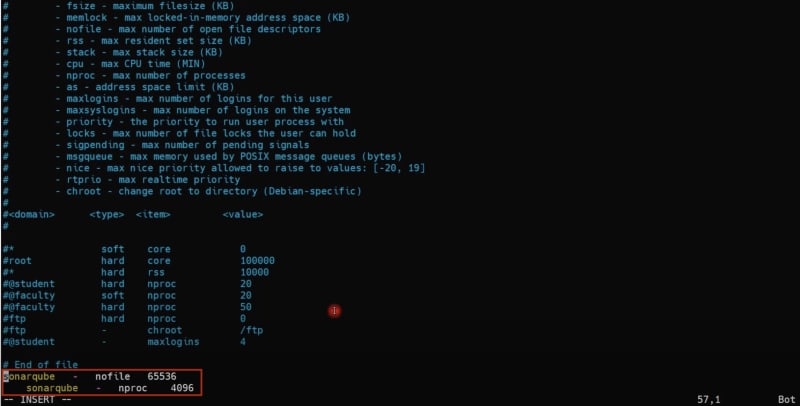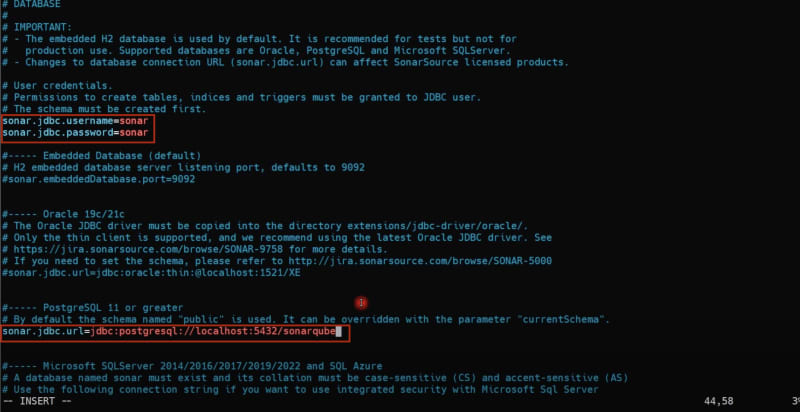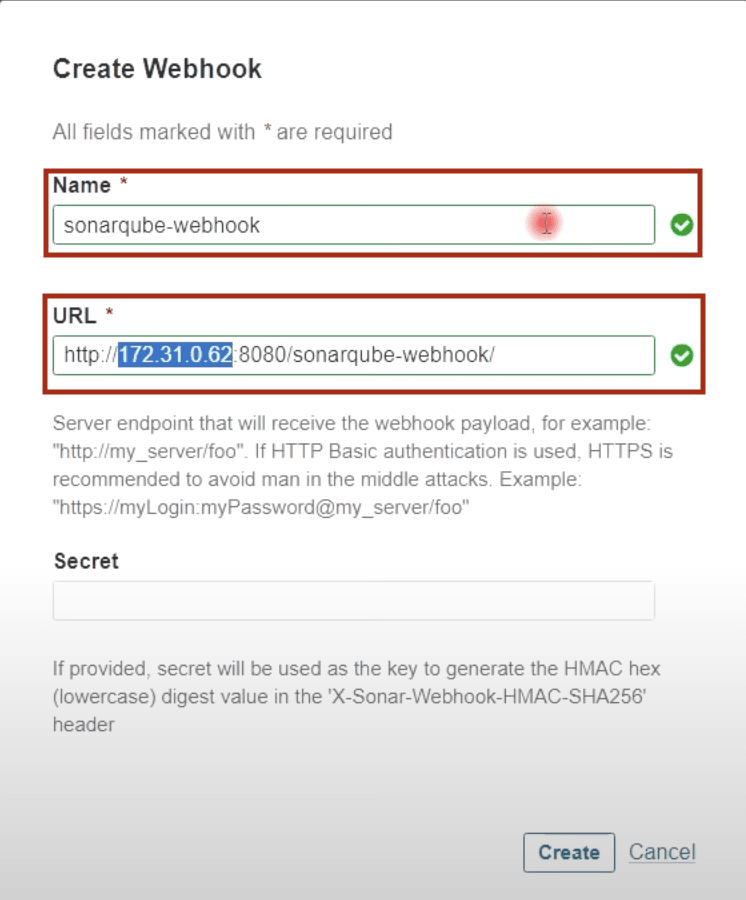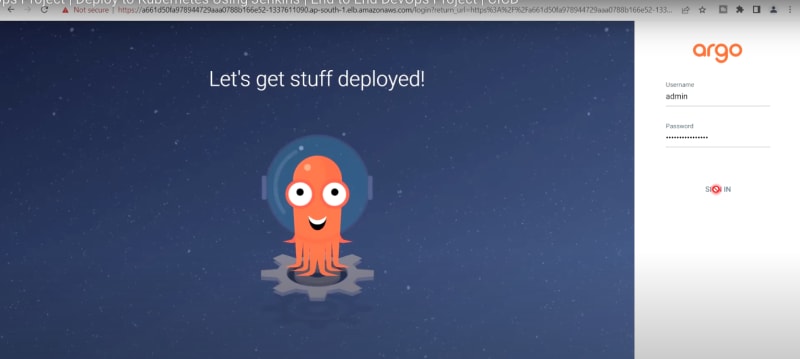Project Overview-
Launch an ec2 server - Jenkins-Master
-
AMI - Ubuntu(Free tier)
-
Instance Type - t2.micro
-
Select or create Key Pair
-
Configuration Storage - 15 GiB
Launch Instance Now
Open 'Terminal', access your Server and run below commands-
//Change directory to the location where key pair file is located
$ cd Downloads
$ ssh -i [keypair-name].pem ubuntu@[public IP]
$ sudo apt update
$ sudo apt upgrade -y
//Change server hostname to avoid confusion
$ sudo hostnamectl set-hostname Jenkins-Master
$ bash
$ sudo apt install openjdk-17-jre -y
$ java -version
$ curl -fsSL https://pkg.jenkins.io/debian/jenkins.io-2023.key | sudo tee
/usr/share/keyrings/jenkins-keyring.asc > /dev/null echo deb [signed-by=/usr/share/keyrings/jenkins-keyring.asc]
https://pkg.jenkins.io/debian binary/ | sudo tee
/etc/apt/sources.list.d/jenkins.list > /dev/null
$ sudo apt-get update
$ sudo apt-get install jenkins
$ sudo systemctl enable jenkins
$ sudo systemctl start jenkins
$ systemctl status jenkins
$ sudo vi /etc/ssh/sshd_configA editor file will open. Press i button on keyboard to enable edit mode and uncomment two lines(Remove '#') as below-
Save & close this file (Press 'esc' button from keyboard and then ':wq' hit enter)
// Now reload the server
$ sudo service sshd reloadGo to AWS Console:
Edit Inbound rules of Jenkins-Master from Security Group to allow jenkins port 8080 -
Launch an ec2 server - Jenkins-Agent
-
AMI - Ubuntu(Free tier)
-
Instance Type - t2.micro
-
Select or create Key Pair
-
Configuration Storage - 15 GiB
Launch Instance Now
Open 'New Terminal', access your Server and run below commands-
//Change directory to the location where key pair file is located
$ cd Downloads
$ ssh -i [keypair-name].pem ubuntu@[public IP]
$ sudo apt update
$ sudo apt upgrade -y
//Change server hostname to avoid confusion
$ sudo hostnamectl set-hostname Jenkins-Master
$ bash
$ sudo apt install openjdk-17-jre -y
$ java -version
//Now install Docker
$ sudo apt-get install docker.io -y
$ sudo usermod -aG docker $USER
// Reboot server now
$ sudo init 6
//After reboot need to reconnect
$ ssh -i [keypair-name].pem ubuntu@[public IP]
$ sudo vi /etc/ssh/sshd_configA editor file will open. Press i button on keyboard to enable edit mode and uncomment two lines(Remove '#') as below-
Save & close this file (Press 'esc' button from keyboard and then ':wq' hit enter)
// Now reload the server
$ sudo service sshd reloadGo to Jenkins-Master server:
$ ssh-keygen // Hit enter till it generates key
$ cd .sh/
$ ls
// You will see files as - authorized_key id_rsa id_rsa.pub
$ sudo cat id_rsa.pub // copy complete key Go to Jenkins-Agent Server:
$ cd .ssh/
$ ls
// You will see files as - authorized_key
$ sudo vi authorized_key
// An editor will open. Paste public key copied from Jenkins-Master server. Save and exitCopy public IP of Jenkins-Master server and paste in the browser with port 8080
$ sudo cat /var/lib/jenkins/secrets/initialAdminPassword
// copy password and paste in Administration Password -> Continue -> Install suggested pluginsCreate first admin user -
Save & Continue -> Save and finish -> Start using jenkins
Jenkins Dashboard-
Manage Jenkins -> Nodes -> Build-in-Node -> Configure
Create new Node -
-
Node name - Jenkins-Agent
-
Type - Permanent Agent
-
Click on 'Create'
-
Description - Jenkins-Agent
-
Number of Executor - 2
-
Remote root Directory - /home/ubuntu
-
Labels - Jenkins-Agent
-
Launch Method - Launch agents via SSH
-
Host - [Jenkins-Agent server private IP]
-
Credentials -> Add -> Jenkins
-
Kind -> SSH Username with private key
-
Id - Jenkins-Agent
-
Description - Jenkins-Agent
-
Username - ubuntu
-
Private Key -> Enter Directly -> Under key Add
Note: Copy private key of Master server (file name - id_rsa) and paste here under add key.
-
Now click on 'Add'
-
Credentials - choose ubuntu(Jenkins-Agent)
-
Host Key verification Strategy - Non verifying Verification Strategy
-
Click on 'Save'
Integrate Maven to Jenkins & add GitHub credentials to Jenkins:
Go to Jenkins Dashboard-
- Manage Jenkins -> Plugins -> Available Plugins
Note: Install selected plugins as shown below
-
Manage Jenkins -> Tools -> find Maven Installation
-
Click on Add maven
-
Name - Maven3
-
Apply & Save
-
Manage Jenkins -> Tools -> find JDK Installation
-
Click on Add JDK
-
Name - Java17
-
Tick on 'Install automatically'
-
Click on Add Installer -> Install from adoptium.net
-
Version -> Under OpenJDK 17 HotSpot -> Choose jdk-17.0.5+8
-
Apply & Save
-
Manage Jenkins -> Under Security choose 'Credentials'
-
Stores scoped to Jenkins - Click on global drop down and Add Credentials
-
Kind - Username with password
-
Username - [GitHub username]
-
Password - [Provide personal access token created in GitHub]
-
Id - github
-
Decription - github
-
Click on 'Create'
Create pipeline script(Jenkinsfile) for build and test Artifacts and Create CI Job on Jenkins
Here is GitHub repository, you can fork it to your account
Go to Jenkins Dashboard -
-
New Item
-
Enter an Item name - register-app-ci -> Select 'Pipeline' -> Click 'Ok'
-
Configuration -> General
-
Tick on 'Discard old build'
-
Max # of builds to keep - 2
-
Under 'Pipeline' -> Definition -> Choose 'pipeline script from SCM'
-
SCM - git
-
Repositories -> Repository URL - [Paste your forked repository URL]
-
Credentials -> Choose [your GitHub Credentials]
-
Branch Specifier - */main
-
Apply and Save
Install and Configure SonarQube-
Go to AWS Console -
-
Launch new ec2 with name as 'SonarQube'
-
AMI - Ubuntu(Free tier)
-
Instance Type - t3.medium
-
Select or create Key Pair
-
Configuration Storage - 15 GiB
Launch Instance Now
Open 'New Terminal', access your Server and run below commands-
//Change directory to the location where key pair file is located
$ cd Downloads
$ ssh -i [keypair-name].pem ubuntu@[public IP of SonarQube Server]
$ sudo apt update
$ sudo apt upgrade -y
$ sudo sh -c 'echo "deb http:https://apt.postgresql.org/pub/repos/apt $(lsb_release -cs)-pgdg main" > /etc/apt/sources.list.d/pgdg.list'
$ wget -qO- https://www.postgresql.org/media/keys/ACCC4CF8.asc | sudo tee /etc/apt/trusted.gpg.d/pgdg.asc &>/dev/null
$ sudo apt update
$ sudo apt-get -y install postgresql postgresql-contrib
$ sudo systemctl enable postgresql
//Create Database for Sonarqube
$ sudo passwd postgres // set the password
$ su - postgres // Provide the password that we set just now
$ createuser sonar
$ psql
# ALTER USER sonar WITH ENCRYPTED password 'sonar';
# CREATE DATABASE sonarqube OWNER sonar;
# grant all privileges on DATABASE sonarqube to sonar;
# \q
$ exit
// Add Adoptium repository
$ sudo bash
# wget -O - https://packages.adoptium.net/artifactory/api/gpg/key/public | tee /etc/apt/keyrings/adoptium.asc
# echo "deb [signed-by=/etc/apt/keyrings/adoptium.asc] https://packages.adoptium.net/artifactory/deb $(awk -F= '/^VERSION_CODENAME/{print$2}' /etc/os-release) main" | tee /etc/apt/sources.list.d/adoptium.list
//Install Java 17
# apt update
# apt install temurin-17-jdk
# update-alternatives --config java
# /usr/bin/java --version
# exit
// Linux Kernel Tuning
$ sudo vi /etc/security/limits.confAn editor file will open. Add below two line at the end of the files-
-
sonarqube - nofile 65536
-
sonarqube - nproc 4097
-
Save and come out of the file using ESC button and :wq + hit enter
$ sudo vi /etc/sysctl.confAn editor file will open. Paste the below line at the end
// reboot server now
$ sudo init 6Note: Edit inbound rules of 'SonarQube' server to allow its port 9000
Access again to SonarQube server using terminal and run the below commands -
//Change directory to the location where key pair file is located
$ cd Downloads
$ ssh -i [keypair-name].pem ubuntu@[public IP of SonarQube server]
// Sonarqube installation
$ sudo wget https://binaries.sonarsource.com/Distribution/sonarqube/sonarqube-9.9.0.65466.zip
$ sudo apt install unzip
$ sudo unzip sonarqube-9.9.0.65466.zip -d /opt
$ sudo mv /opt/sonarqube-9.9.0.65466 /opt/sonarqube
// Create user and set permissions
$ sudo groupadd sonar
$ sudo useradd -c "user to run SonarQube" -d /opt/sonarqube -g sonar sonar
$ sudo chown sonar:sonar /opt/sonarqube -R
// Update Sonarqube properties with DB credentials
$ sudo vim /opt/sonarqube/conf/sonar.propertiesAn editor will open. Find, uncomment and replace below values, you might need to add the sonar.jdbc.url
-
sonar.jdbc.username=sonar
-
sonar.jdbc.password=sonar
-
sonar.jdbc.url=jdbc:postgresql:https://localhost:5432/sonarqube
// Create service for Sonarqube
$ sudo vim /etc/systemd/system/sonar.service //Paste the below into the file [Unit] Description=SonarQube service After=syslog.target network.target
[Service]
Type=forking
ExecStart=/opt/sonarqube/bin/linux-x86-64/sonar.sh start
ExecStop=/opt/sonarqube/bin/linux-x86-64/sonar.sh stop
User=sonar
Group=sonar
Restart=always
LimitNOFILE=65536
LimitNPROC=4096
[Install]
WantedBy=multi-user.target// Start Sonarqube and Enable service
$ sudo systemctl start sonar
$ sudo systemctl enable sonar
$ sudo systemctl status sonar
// Watch log files and monitor for startup
$ sudo tail -f /opt/sonarqube/logs/sonar.logCopy public IP of SonarQuber server and paste in the browser with port 9000
Note: By default SonarQube's username is 'admin' and password is also 'admin'
Integrate SonarQube with Jenkins
From SonarQube Console-
-
Click on profile -> My Account -> Security
-
Name - jenkins-sonarqube-token
-
Type - Global Analysis Token
-
Expire in - Never
-
Click on generate Note: Copy token & save it
Go to Jenkins Dashboard-
-
Manage jenkins -> Credentials -> Add new Credentials
-
Kind - Secret Text
-
Secret - [Paste jenkins-sonarqube-token here]
-
Id - jenkins-sonarqube-token
-
Description - jenkins-sonarqube-token
-
Now click on 'create'
-
Go to plugins and Download plugins for SonarQube and install it
-
Restart Jenkins
-
Manage Jenkins -> System -> Search for 'SonarQube Servers' -> Add SonarQube
-
Name - sonarqube-server
-
Server URL - http:https://[private IP of Sonar server]:9000
-
Server authentication Server - Select 'jenkins-sonarqube-token'
-
Apply & Save
-
Manage jenkins -> Tools
-
Search 'SonarQube Scanner installations' -> Add SonarQube Scanner
-
Name - sonarqube-scanner
-
Apply & Save
Go to SonarQube Dashboard-
-
Create Webhook
-
Name - sonarqube-webhook
-
URL - http:https://[Private IP of Jenkins-Master]:8080/sonarqube-webhook/
Build and Push Docker Image using Pipeline Script
Go to Jenkins Dashboard-
-
Download all Plugins for Docker and install it
-
Restart Jenkins
-
Now, add credentials for Docker in Jenkins
Note: Before adding credentials in Jenkins create a New access token from dockerhub and use the same while adding credentials in Jenkins.
-
Id - dockerhub
-
Description - dockerhub
Setup Bootstrap server for eksctl and setup Kubernetes using eksctl
Go to AWS Console
-
Name - EKS-Bootstrap-Server
-
AMI - Ubuntu(Free tier)
-
Instance Type - t2.micro
-
Select or create Key Pair
-
Configuration Storage - 15 GiB
Launch Instance Now
//Install AWS Cli on the above EC2
$ curl "https://awscli.amazonaws.com/awscli-exe-linux-x86_64.zip" -o "awscliv2.zip"
$ apt install unzip
$ unzip awscliv2.zip
$ sudo ./aws/install
$ /usr/local/bin/aws --version
//Installing kubectl
$ curl -O https://s3.us-west-2.amazonaws.com/amazon-eks/1.27.1/2023-04-19/bin/linux/amd64/kubectl
$ ll
$ chmod +x ./kubectl //Gave executable permisions
$ mv kubectl /bin //Because all our executable files are in /bin
$ kubectl version --output=yaml
$ curl --silent --location "https://github.com/weaveworks/eksctl/releases/latest/download/eksctl_$(uname -s)_amd64.tar.gz" | tar xz -C /tmp
$ cd /tmp
$ ll
$ sudo mv /tmp/eksctl /bin
$ eksctl versionGo to AWS Console and create one IAM role
-
Select AWS Service
-
Service or Use Case - EC2
-
Add Permission - AdministrationAccess
-
Name - eksctl_role
-
Click on Create role
-
Back to Instances
-
Select 'EKS-Bootstrap-Server'
-
Click on 'Action' drop down
-
Go to 'Security'
-
Click on 'Modify IAM role'
-
Click on 'Choose IAM role'
-
Select 'eksctl_role'
-
Click 'Update IAM role'
Go to EKS-Bootstrap-Server terminal
// Setup Kubernetes using eksctl
$ eksctl create cluster --name [name of cluster]
--region ap-south-1
--node-type t2.small
--nodes 3 \ //Minimum 3 nodes required for this project
$ kubectl get nodesArgoCD Installation on EKS Cluster and Add EKS Cluster to ArgoCD
On EKS-Bootstrap-Server terminal
$ kubectl create namespace argocd
//Next, let's apply the yaml configuration files for ArgoCd
$ kubectl apply -n argocd -f https://raw.githubusercontent.com/argoproj/argo-cd/stable/manifests/install.yaml
//Now we can view the pods created in the ArgoCD namespace.
$ kubectl get pods -n argocd
//To interact with the API Server we need to deploy the CLI:
$ curl --silent --location -o /usr/local/bin/argocd https://github.com/argoproj/argo-cd/releases/download/v2.4.7/argocd-linux-amd64
$ chmod +x /usr/local/bin/argocd
//Expose argocd-server
$ kubectl patch svc argocd-server -n argocd -p '{"spec": {"type": "LoadBalancer"}}'
//Wait about 2 minutes for the LoadBalancer creation
$ kubectl get svc -n argocd
//Get pasword and decode it.
$ kubectl get secret argocd-initial-admin-secret -n argocd -o yaml
$ echo WXVpLUg2LWxoWjRkSHFmSA== | base64 --decodeCopy DNS name for the LoadBalancer, created for the argocd-cluster and paste it in the browser
Login to argoCD using admin as username and decoded password
Note: Update password once you are logged in
Login to argocd in Terminal
$ argocd login [url of argocd_cluster] --username admin // Use updated passwordGo to ArgoCD Dashboard -> Setting -> Clusters
Note: We can see default cluster here. We can see same cluster using CLI
$ argocd cluster list
//To get details of eks_cluster
$ kubectl config get contexts
//To add eks_cluster to argocd
$ argocd cluster add [name of eks-cluster] --name shamim-eks-cluster
$ argocd cluster listNote: Go to argocd and you can see created cluster there.
Configure ArgoCD to deploy Pods on eks and Automate ArgoCD Deployment job using GitOps GitHub Repository
Note: We need another repository and can be forked from https://github.com/MSFaizi/gitops-register-app.git
Go to ArgoCD Dashboard and configure this repository.
-
Dashboard -> Settings -> Repositories -> Connect Repo
-
Via HTTPS
-
Type - git
-
Project - Default
-
Repository URL - [gitops-register-app github URL]
-
Username - [GutHub username]
-
Password - [GitHub account password]
-
Click on 'Connect' Note: It will show 'Successful' as connection status
-
Dashboard -> New App ->
-
Application Name - register-app
-
Project Name - default
-
Sync Policy - Automatic
-
Tick on 'Prune Resources' and 'Self Heal'
-
Repository URL - Select added one
-
Revision - Head
-
Path - ./
-
Cluster URL - Select added one from drop down
-
Namespace - default
-
Now click on create
Go to EKS-Bootstrap-Server terminal
//To see pods
$ kubectl get pods
// To get external DNS name for app
$ kubectl get svc // Copy DNS name and paste in the browser with port 8080 We can see default homepage of Apache server
Put /webapp after port 8080 in the browser
Go to Jenkins Dashboard in the browser
-
Dashboard -> New Item
-
Item Name - gitops-register-app-cd
-
Select 'Pipeline' and click OK
-
Tick 'Discard old builds'
-
Max # builds to keep - 2
-
Tick on 'This project is parameterized'
-
Add Parameter - String Parameter
-
Name - IMAGE_TAG
-
Tick on 'Trigger builds remotely (e.g. from scripts)'
-
Authentication token name - gitops-token
-
Under Pipeline -> Definition - pipeline script from SCM
-
SCM - git
-
Repository URL - [gitops-register-app gitHub URL]
-
Credentials - Select github credential [If dont show in drop down then add it from Jenkins Credentials settings]
-
Branch Specifier - */main
-
Apply & Save
-
Click on User profile -> Configure
-
Under API toke click on 'Add new token'
-
Give name as 'JENKINS_API_TOKEN' and click on Generate Note: Copy token and save it
-
Apply & Save
-
Dashboard -> Manage Jenkins -> Credentials
-
Click on global and and add Credentials
-
Kind - Secret text
-
Secret - [paste JENKINS_API_TOKEN code here]
-
Description - JENKINS_API_TOKEN
-
Click on create
Verify CI/CD pipeline by doing test commit on GitHub Repo
Go to Jenkins Dashboard again
Note: Now you can test this pipeline as many times as you want by changing to the code and pushing them to GitHub



